|
|
Post by Reptisaurus! on May 24, 2019 13:46:19 GMT -5
There was a variant of Ka-Zar in a '50s Atlas/Marvel jungle comic I had... behold Lo-Zar!!!  Leopard Girl was by Al Hartley... kind of a Millie The Model jungle queen. Lo-Zar appeared in all six issues apparently, no sign of any large kitty friend with an overbite though. I'm guilty of Sub-mareeeeen-er. I was a big watcher of Marine Boy on tv.  Oh My God, I care so much about Atlas Jungle Comics! Leopard Girl is the best. It blows my mind no-one has brought her back. Worth noting that Ka-Zar (not THAT Ka-Zar, but *A* Ka-Zar) had a sustained run in the original Marvel Mystery Comics, starting in '39. Fun tvivia: This Ka-Zar strip had the first two page spread in comics, as far as we know. The Kirby Ka-Zar is, I THINK the only Kirby stuff for Marvel after 1963 or so that I haven't read. Is it reprinted anywhere other than an OOP Masterworks Volume? Heh. Lo-Zar. |
|
|
|
Post by beccabear67 on May 24, 2019 16:17:11 GMT -5
The Kirby Ka-Zar is, I THINK the only Kirby stuff for Marvel after 1963 or so that I haven't read. Is it reprinted anywhere other than an OOP Masterworks Volume? You mean from Astonishing Tales #1 & 2? I don't know. #3-onward was Barry Smith and others. I had the first two ages ago and they had Kraven The Hunter in both, first story credited to Stan Lee, but they don't stand out in my memory as much as the Wally Wood Dr. Dooms.  |
|
|
|
Post by profh0011 on May 25, 2019 16:44:15 GMT -5
If Kirby drew it, Kirby WROTE the stories.
As I recall, the most memorable thing about the Kirby KA-ZAR episodes in ASTONISHING TALES was Sam Grainger's inks. He was one of Kirby's best inkers from that period, and it seems a shame he didn't ink much more of Kirby's work.
|
|
|
|
Post by chaykinstevens on May 25, 2019 17:11:57 GMT -5
According to GCD, some of Kirby's artwork in Astonishing Tales #2 was modified by other artists, possibly including Marie Severin and Barry Smith.
|
|
|
|
Post by Reptisaurus! on May 25, 2019 17:52:52 GMT -5
If Kirby drew it, Kirby WROTE the stories. As I recall, the most memorable thing about the Kirby KA-ZAR episodes in ASTONISHING TALES was Sam Grainger's inks. He was one of Kirby's best inkers from that period, and it seems a shame he didn't ink much more of Kirby's work. Sorry, I gotta be the guy with the boring facts again.  It must be nice to be able to use fun imagination all the time. By this time in their relationship Kirby was really burned out at (A) not receiving full credit for his creative contributions (B) Feeling that Marvel undervalued him as an employee and didn't trust them to honor contracts, and (C) feeling that his stories were undermined by Stan/editorial in plot but most especially in theme. (Fantastic Four # 66-67, where the story was completely changed in a way that did not reflect Kirby's intent, is generally considered to be the "last straw" but this could be an urban legend.) So this resulted in two things: (A) The Lee/Kirby balance, where Kirby had been in charge of the direction of the stories had shifted, and Lee was now more in charge of the general direction of the books than he had been probably ever. (Again, this was Kirby's decision, not Stan's) Side-note: Kirby still did the overwhelming majority of the actual writing work of telling the story. and (B) The books Kirby worked on got much worse. (Ok, this is 100% opinion on my part but nobody here is gonna disagree with me, right? Except Thor which was gold right up till the end. I suspect based on no real evidence whatsoever that Kirby except intuition was more involved.) It's important to note, for clarity, that Lee did script the Ka-Zar series. (Unless the GCD is wrong.) EDIT: *I* was wrong. Roy Thomas scripted # 2. This is important to note for clarity because Kirby did (in fact) do 100% of the writing from plotting, to nuts-and-bolts storytelling to scripting on the Inhumans series which ran concurrently in Amazing Adventures. So when you say that Kirby "WROTE" Ka-Zar it's confusing because there were books released at the same time that Kirby solo wrote. |
|
Confessor
CCF Mod Squad
Not Bucky O'Hare!
Posts: 10,202 
|
Post by Confessor on May 25, 2019 18:07:17 GMT -5
A caption on page 1 of X-Men #10 (his first appearance) says it's "Kay-Sar". This is a case where I just refuse to accept Stan's official pronunciation. It's KAH-ZAR, equal stress on both syllables, hard 'z' sound, not an 's' sound. Look, it's not like the Savage Land has a formal transliteration of its language to the Latin alphabet! It's gotta be a purely phonetic representation. Why use a 'Z' in a fictional name unless it's going to be pronounced like a 'Z'? And 'Ka' is just not a reasonable phonetic representation of a spoken "kay" (with a long a), but it would naturally be read as "kah" (I grant you, one might argue that this would be read as sounding like the 'a' in "cat", but come on, that just doesn't sound like a jungle lord name, does it?). Equal stress on both syllables is debatable, but I don't like to de-emphasize the first because it comes out sounding too reminiscent of "Shazam". I couldn't agree more. To me, he'll always be KAH-ZAR. |
|
|
|
Post by chaykinstevens on May 25, 2019 18:19:09 GMT -5
It's important to note, for clarity, that Lee did script the Ka-Zar series. (Unless the GCD is wrong.) Roy Thomas scripted the Ka-Zar story in AT #2. |
|
|
|
Post by Reptisaurus! on May 25, 2019 18:24:27 GMT -5
It's important to note, for clarity, that Lee did script the Ka-Zar series. (Unless the GCD is wrong.) Roy Thomas scripted the Ka-Zar story in AT #2. Thank you, sorry, I only looked up # 1. I think I might be not reading these stories on purpose because psychology. (The same with The Losers from DC.) I really, really, like '60s and '70s Kirby. And it would make me sad if there were no more left in the world that I hadn't read. |
|
|
|
Post by codystarbuck on May 25, 2019 20:55:13 GMT -5
Roy Thomas scripted the Ka-Zar story in AT #2. Thank you, sorry, I only looked up # 1. I think I might be not reading these stories on purpose because psychology. (The same with The Losers from DC.) I really, really, like '60s and '70s Kirby. And it would make me sad if there were no more left in the world that I hadn't read. The Losers run is definitely worth reading. Kirby filtered in his WW2 experiences and it isn't the Wahoo silliness of Sgt Fury. One story, with a pulp-sci-fi loving stand-in for Jack is a bit hokey; but, there are good stories there. |
|
|
|
Post by profh0011 on May 26, 2019 12:59:22 GMT -5
It's simple, but the way the credits were written deliberately confused it.
Kirby wrote the STORIES. Entirely on his own with no input from anybody.
Others wrote the DIALOGUE. Often DRASTICALLY changing the stories in ways most readers remain unaware of to this day.
The "Him" story in FF (intended as a 4-parter) may be the most known, but it's far from the only time that happened. The mutilation of Kirby's work was an ongoing thing, but somehow actually managed to get worse during the last 3 years he was at Marvel, as there was a concerted effort to drive him out of the company.
|
|
|
|
Post by Reptisaurus! on May 26, 2019 14:45:42 GMT -5
It's simple, but the way the credits were written deliberately confused it. Kirby wrote the STORIES. Entirely on his own with no input from anybody. Others wrote the DIALOGUE. Often DRASTICALLY changing the stories in ways most readers remain unaware of to this day. The "Him" story in FF (intended as a 4-parter) may be the most known, but it's far from the only time that happened. The mutilation of Kirby's work was an ongoing thing, but somehow actually managed to get worse during the last 3 years he was at Marvel, as there was a concerted effort to drive him out of the company Depending on your definition of "wrote," yes. Kirby made the vast majority of the choices on how the narrative was constructed. Obviously were not going to see eye to eye on this. Psychologically, you seem to want to reduce this situation down to the simplest possible interpretation that is still slightly correct. (Or at least more correct than saying Stan Lee wrote the stories, which would be the most simpleminded interpretation.) I'm an American, I'm aware of American politics, I understand the need for simple, straightforward beliefs as a foundation for identity. Conversely, I always am looking for complex, nuanced answers. If I wanted to talk about this in essay format, I would spend a thousand words defining "wrote." This puts us at an impasse. Your interpretation is, to me, frustratingly and maddeningly imprecise. If you keep saying "Kirby WROTE the stories" you're assuming that Kirby never worked full script (which I dunno, but I find unlikely. What was he doing after breaking up with Joe Simon but before going full time at Marvel?) and you're not distinguishing the stories Kirby wrote the dialog. Side-Note: I can't remember what else Kirby fully-scripted at Marvel pre-1971 aside from Inhumans but I know there was at least one more story. I can't figure out how to google this and it is driving me insane. So I guess our permanent relationship will always be you "SIMPLE STATEMENT." Me, "Well, sure SIMPLE STATEMENT to a degree, but also not because" I'm a litte excited, tbh. I love, love, love researching this stuff. Although I'm jealous: Your job seems far easier and less time consuming. but I guess that's the price i pay for my shades of grey worldview. And it's interesting. Usually when I argue this with people who have your degree of ... didacticism? Is that the right word? They are arguing for Stan Lee as the sole writer. I figure this is because they read Stan's account first at an early age, and absorbed the idea of "Stan = Marvel = my favorite corporation" so Stan is tangled up in their core beliefs about themselves. Conversely, I've never met, online or IRL, anyone who acts quite like you so I don't understand why you are making the choices you make. |
|
|
|
Post by chaykinstevens on May 27, 2019 6:20:29 GMT -5
Side-Note: I can't remember what else Kirby fully-scripted at Marvel pre-1971 aside from Inhumans but I know there was at least one more story. I can't figure out how to google this and it is driving me insane. GCD credits Kirby with solo-scripting one story in each of Chamber of Darkness #4 & 5. |
|
|
|
Post by beccabear67 on May 27, 2019 11:50:41 GMT -5
I don't want to get into an argument about Lee Vs. Kirby... not without any inside information, but I think Stan's scripting was extremely innovative and a major selling point for the comics. Kirby was very much lacking in that area while being one of the greatest in so many other areas. Kirby had huge ideas obviously, but his dialogue was often weak and even awkward. Similarly Steve Ditko's solo dialogue was more polemical and odd, which may be charming to me but I can understand how it might fall flat with others.
|
|
|
|
Post by Icctrombone on May 27, 2019 13:31:03 GMT -5
I don't want to get into an argument about Lee Vs. Kirby... not without any inside information, but I think Stan's scripting was extremely innovative and a major selling point for the comics. Kirby was very much lacking in that area while being one of the greatest in so many other areas. Kirby had huge ideas obviously, but his dialogue was often weak and even awkward. Similarly Steve Ditko's solo dialogue was more polemical and odd, which may be charming to me but I can understand how it might fall flat with others. I always thought that the scripting was a key component to the success of these books. Kirby's scripting in the Fourth World stuff was largely forgettable. |
|
|
|
Post by codystarbuck on May 27, 2019 15:28:58 GMT -5
Marvel Premiere #54 Had this comic been done by Fantagraphics, that title would have a whole different connotation. Definite Clint Eastwood vibe on that cover, right down to using a Colt Army Model percussion revolver. These were not cartridges; they were ball&cap. You loaded powder into the cylinder, then a pistol ball and tamped it down. Then, percussion caps were loaded on nibs, at the hammer end of the cylinder. The hammer would strike the percussion cap, which ignited the powder and launched the pistol ball. It created a ton of smoke, too. Creative Team: Peter Gillis-writer, Gene Day-pencils, Tony De Zuniga-inks, John Costanza-letters, Ben Sean-colors, Jim Salicrup-edits Synopsis: The year is 1890 (according to the splash page)... 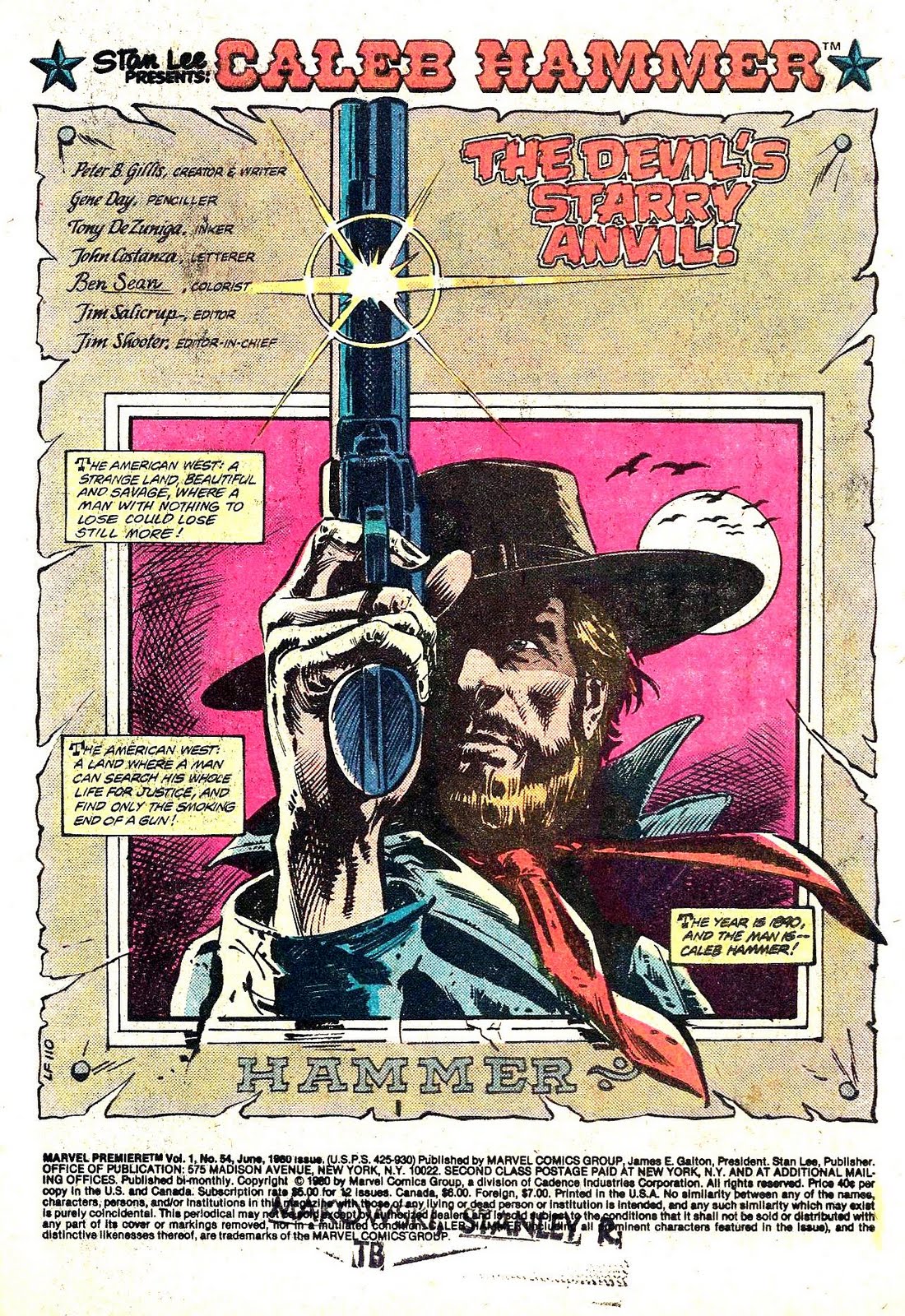 We are in manacle, WY, which we are told is a dying town. A local punk, looking for a reputation, picks a fight with Caleb Hammer, which allows for some exposition about hunting for some ex-soldiers. The punk goes to draw; but, Caleb takes a turn from Trinity's handbooks and handles things differently... 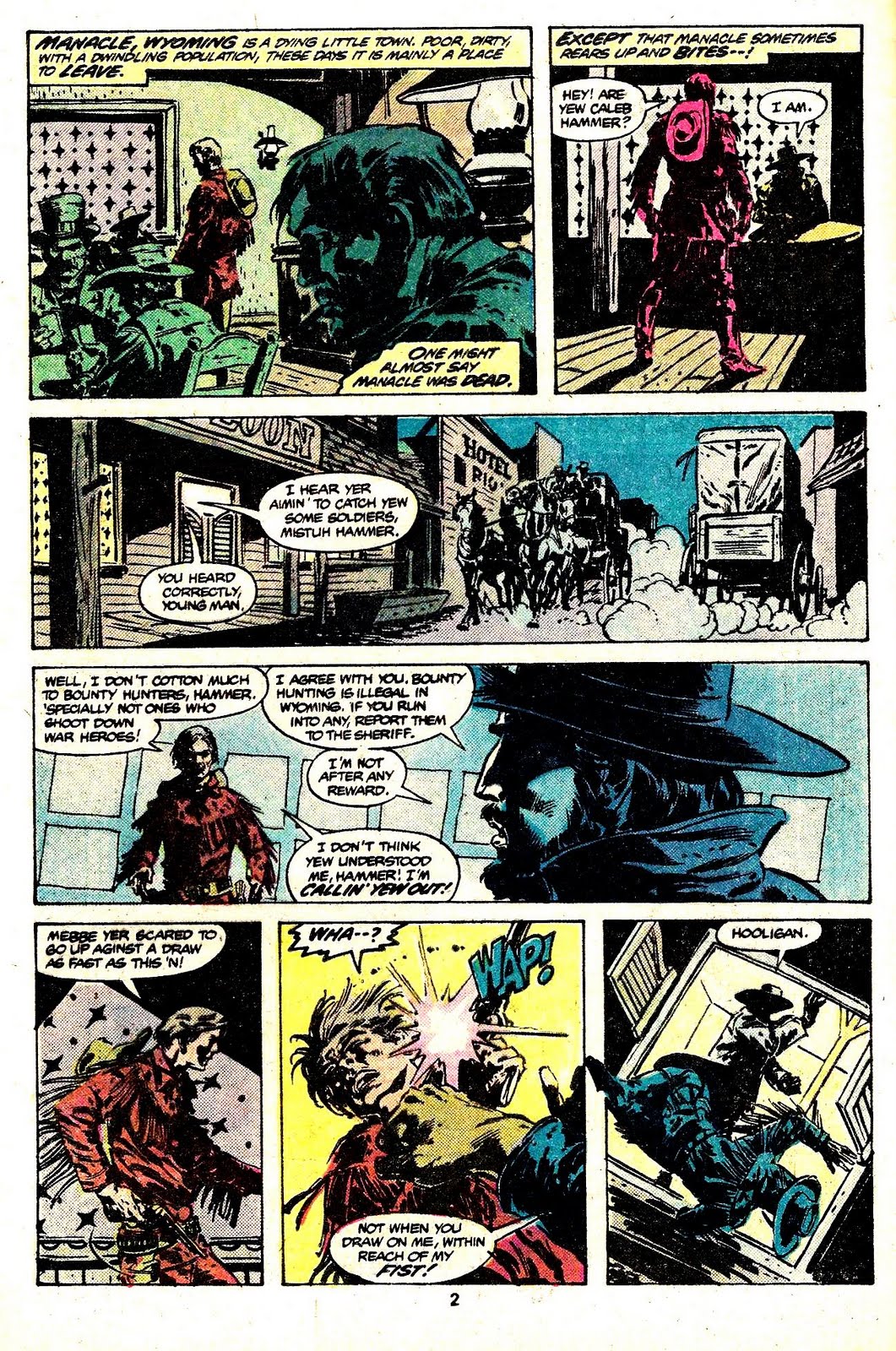 The sheriff comes in and asks for introductions and we learn that Caleb is a Pinkerton agent. he's hunting for Crawford Mckie and James Lovelace, who have left a trail of bodies wherever they have gone. They were soldiers, who took part in the capture of Geronimo, then were decorated and discharged. They went from town to town, using the medals for acclaim, then robbing and killing the townspeople. They came to Manacle, but pickings were slim and moved on. Caleb follows. On the trail, Luke Sommers, the punk, catches up with him to finish their argument. caleb flashes baclk to his wife's murder, at the hands of a drunk soldier, who thought she was his cheating wife. Caleb was training to be a minister; but, abandoned the calling. Now, he faces Sommers. Sommers aims to kill him; but, Caleb has palmed a rock and whips it at his temple, causing him to drop his gun. Caleb then snaps off the cylinder... 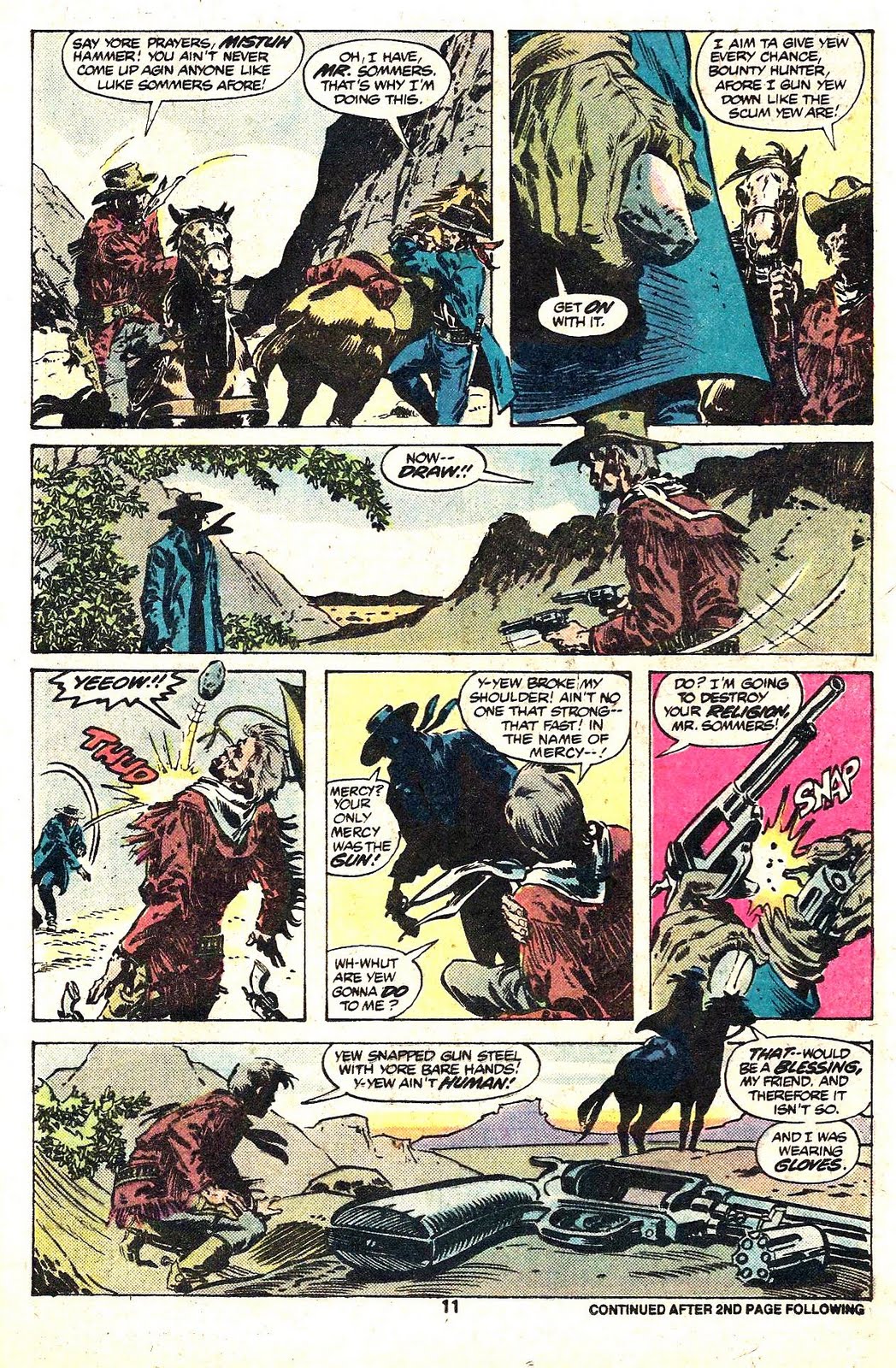 Caleb tracks to a farm that hasn't yet been abandoned, and sees signs that the family was taken, by force. he goes to the parn and trips a rope, setting off an explosion and fire. The horses run out; but Caleb rescues a foal, that is trapped. He flashes back to 1886, at the McCormick Manufacturing plant, in Chicago, where the Pinkertons are acting as strike breakers, when the police are called in and a riot ensues. Caleb's younger brother, Isaak, is killed. 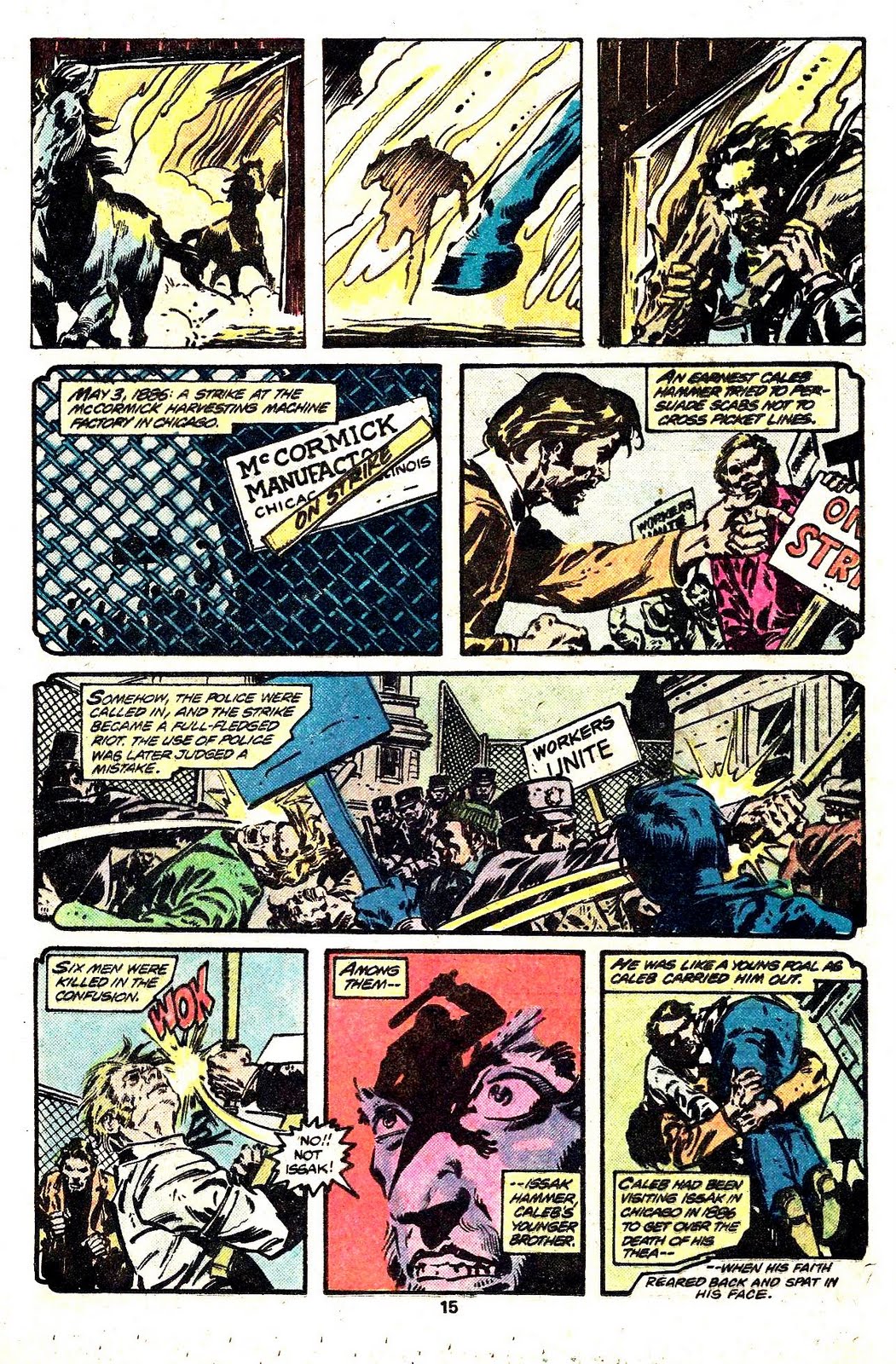 Back in the present, Caleb has tracked the killers and their hostages to a place called The Devil's Anvil. He waits. He makes wolf howls to unnerve the killers, while the rancher mentions indian spirits. Caleb flashes back to another past mission. In the present, the mother pleads for her son, who is sick. Caleb busts through a window and takes out one killer, while the boy has a seizure. he takes down the other; but the boy dies. The two killers are taken alive; but there is still tragedy. 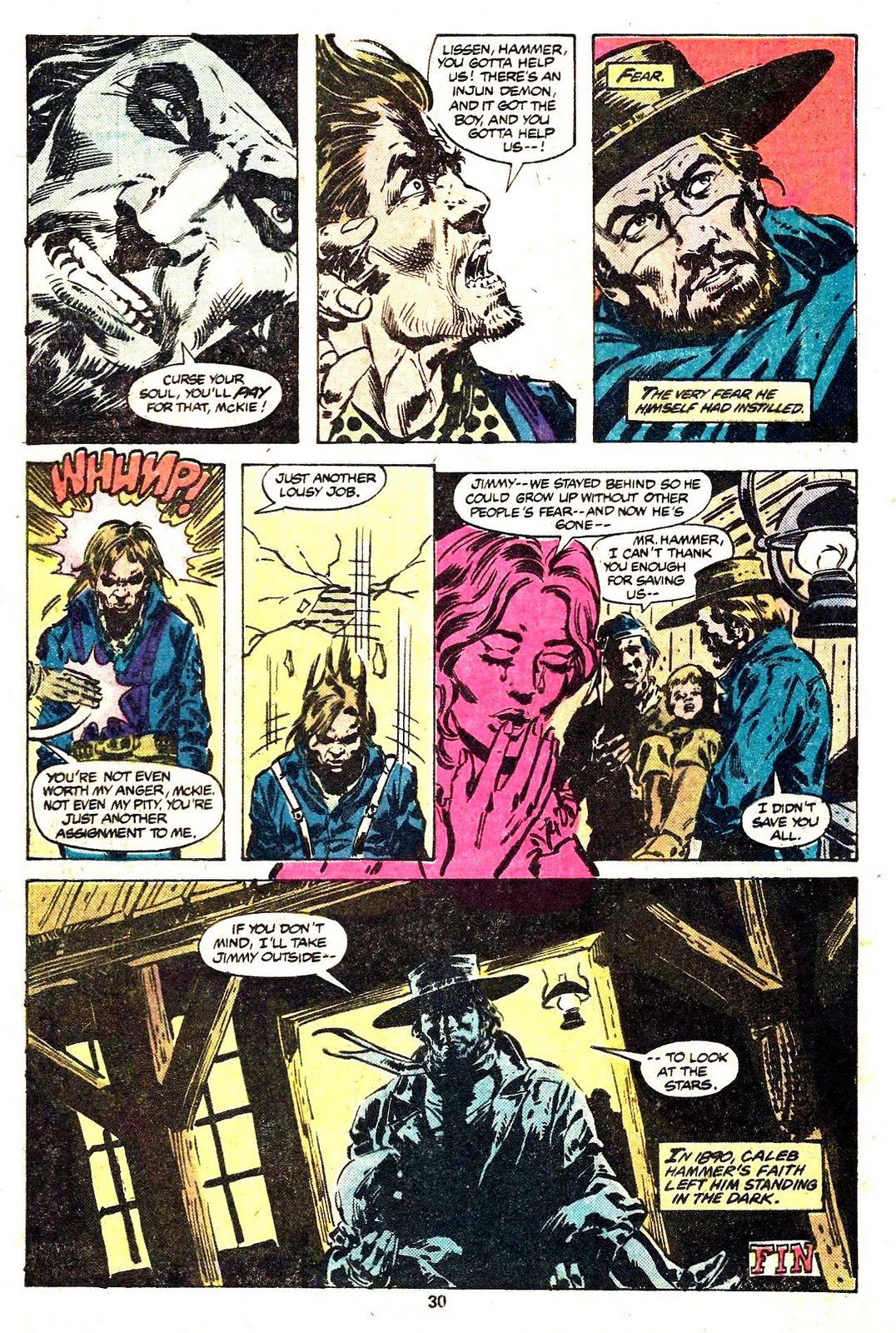 Thoughts: Thoughts: There is a good story here, and a terrific character; but, the constant flashbacks interrupt the flow of the present story. better to have gotten the backstory in one go and then finished the modern story. There is a definite Clint Eastwood "Modern Western" feel to this, where even the heroes have shades of grey and things don't always go well for the white hat. Caleb settles things without ever firing his gun, which is interesting. A Pinkerton agent is a favorite character type for a western, especially for a writer who has done their research. the Pinkerton name was built in the 1800s and Dime Novels added to the lore, though the truth is a bit murkier. Pinkerton was used to infiltrate unions and break strikes by several businessmen, including the infamous Homestead Strike. Pinkerton became synonymous with hired muscle, designed to intimidate workers and prevent them from bringing labor action for fair wages. They were also involved in fighting the Molly Maguires. When the Dept. of Justice was formed, the appropriations weren't enough to create their own investigative branch and much work was farmed out to Pinkerton. They even provided bodyguard services, until new laws were passed, banning them from serving the government, due to the strikebreaking activities. They were also often contracted to hunt down outlaws, such as the James Gang. Pinkerton agents are favorites of modern western writers and even Steampunk afficianadoes, as men of action. Caleb is a deeply troubled man, who gave up the ministry after the death of his wife and further death of his brother. We see he works to take down his prey, without guns, in contrast to the cover. I suspect part of that might be why we didn't see more , until John ostrander used him in Blaze of Glory, in 2000, some 20 years later. That mini gave a modern remake of Marvel's Western characters. At this point in time, the Western was all but dead, with DC's Jonah Hex about the only survivor. it, too, was inspired by Eastwood and the Spaghetti Westerns; but, that one revelled more in its violence, thoguh it told some of the best stories of the age. Marvel had abandoned westerns long before; and, despite a few things (like Blaze of Glory and the Rawhide Kid mini) never really returned to it. DC would turn Jonah Hex into a Mad Max wannabe, with Hex; but, that was a last hurrah, before Joe Lansdale and Tim truman would bring Jonah back for some new Mojo, adding the "weird" to Weird Western. The shame of this is that there is a good character here and much could be done with him; but, it wasn't the right time, nor was it the right place. Gene Day and Tony DeZuniga are terrific on the art and Day knew how to pace this kind of stuff. DeZuniga was best when working on more realistic strips, rather than superheroes. Gillis' script is good; but, needed reworking. Too bad his editor was Jim Salicrup and not Archie Goodwin. A stronger story person is needed to guide things. Next; Caleb gets one story and we return to superheroes, as Simon Williams gets a solo story.
|
|